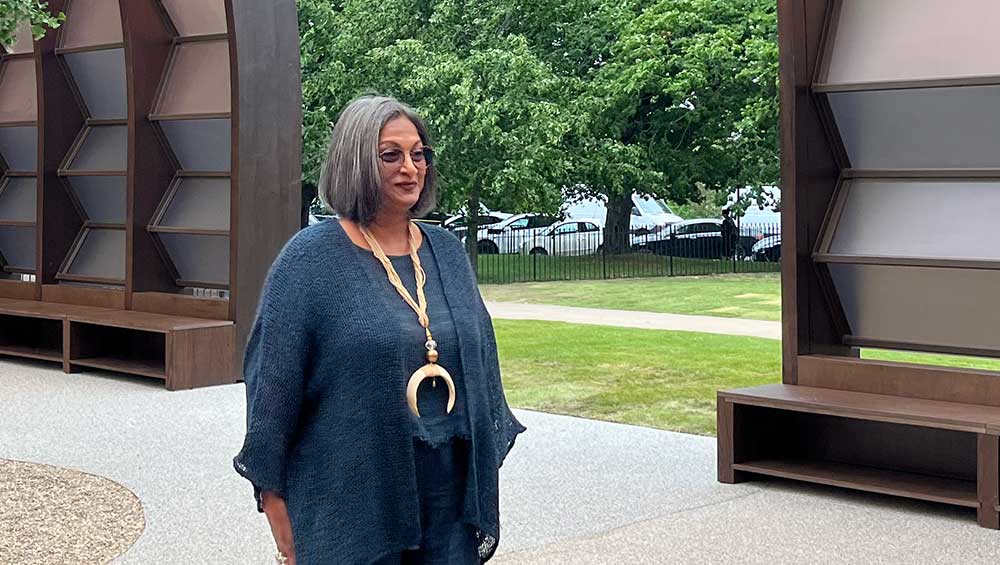
Marina Tabassum at the opening of A Capsule in Time, Serpentine Pavilion, London, 2025. Photo: Veronica Simpson.
by VERONICA SIMPSON
When Marina Tabassum was studying architecture at Bangladesh University of Engineering and Technology in the early 1990s, she first encountered the parliament complex by Louis Kahn, a building that she has said had a seminal influence on her practice. Completed in 1982 (after Kahn’s death in 1974), it is famous for its interconnecting geometric forms and monumental scale – huge circles, triangles and rectangles are woven into a harmonious and integrated composition. Bold apertures punctuate the brick and stone building to conjure rich atmospheres moderated by the weather, and a sense of spirituality and openness. There is a strong connection with nature – the watery plateau around it – while open air walkways and courtyards promote circulation and foster community. At her Soane Medal lecture at the Sir John Soane’s Museum in 2021, Tabassum told the audience: “How the atmosphere inside a building, in this building, could change with the movement of the sun and clouds was my first lesson in daylight.” There are echoes of this inspirational structure’s geometries and porosity in Tabassum’s first building outside Bangladesh, the Serpentine Pavilion. While the timber arches that support the pavilion rise high towards Kensington Gardens’ tree canopy, it is a building that sits prettily within the park, centred around a tall ginkgo tree, its four sections parted to reveal the skies, with the option to telescope one or two of them together to create a more enclosed, rainproof setting for the Serpentine’s summer long programme of talks and music.
.jpg)
Bait Ur Rouf Mosque, Dhaka, by Marina Tabassum Architects. Photo: Hasan Saifuddin Chandan.
It is a fine and fitting 25th iteration of this landmark commission, conceived in 2000 by Zaha Hadid and the then director of the Serpentine, Julia Peyton-Jones, and launched with one of Hadid’s structures that same year. The idea was to offer architects who have not previously built in the UK an opportunity to demonstrate their flair and ingenuity. But it is more remarkable for the Serpentine team to have wooed Tabassum, who has enjoyed a stellar career and been garlanded with prizes (the Aga Khan Award for Architecture in 2016 for her Bait Ur Rouf Mosque, the Jameel Prize from the V&A for Islamic art and architecture in 2018, and the Sir John Soane Medal in 2021). But early in her practice she set out to build locally, to stay true to the identity and materials of her beloved Bangladesh. So, it is all the more exciting to see a building of hers in London.
She rejected the proliferation of corporate architecture she saw around her as Dhaka experienced a development boom, not wanting to contribute to a “generation of fast-bred buildings, primarily focused on profitability”, as she told the Soane audience. “The icon-mania of the super-rich and stardom of architects brought about a crisis. It is a point of crisis when an architect must decide whether to indulge in easy excitement or to choose a path of resistance. I chose to resist, to deny temptation and to search within; within the land I grew up in, the place and country I call home.”
So, in 1995 she formed Urbana with her then partner, Kashef Chowdhury, choosing to create beautiful but modest budget residences out of local materials, using traditional techniques. They landed the commission to design the Museum of Independence of Bangladesh in Dhaka, which was completed in 2013. By then, she had decided to go solo, setting up Marina Tabassum Architects (MTA) in 2005. Her grandmother offered her some land on which to build a mosque, Bait Ur Rouf Mosque, which ended up being crowdfunded and substantially locally built. Winning the Aga Khan Award, this project really put MTA on the map. But rather than chasing after commissions for high-status baubles from wealthy benefactors, MTA has dedicated much of its time to devising structures that resolve the hazardous conditions for refugees and those navigating difficult climatic conditions. The studio created simple, modular, demountable homes on stilts for workers living in the flood-prone conditions of the Panigram Resort, Jessore, so they could up sticks and move whenever they needed to. Likewise, a flatpack project, called the Khudi Bari, was the result of brainstorming during the Covid pandemic in 2020: a lightweight modular structure of bamboo and steel, offering 15 sq metres of accommodation and costing £300 apiece. Hundreds of families have been housed in these structures already.

Khudi Bari by Marina Tabssum Architects. Photo: City Syntax.
Tabassum’s Serpentine Pavilion, called A Capsule in Time, draws on the South Asian architectural tradition of shamiana, ceremonial tents or awnings used for gatherings. Her first entirely wooden construction (sustainably sourced), it has built-in shelving – with the idea of living on as a library, after its Serpentine tenure ends. Each segment is filled with a gentle zigzag arrangement of semi-translucent window panels, tinted in the colours of coffee (from americano to macchiato) and tea.
Studio International spoke to the architect by Zoom before the Pavilion opened, and again, in person, at the opening.
Veronica Simpson: When you first consolidated your vision and philosophy of staying local, celebrating place, working in sympathy with local materials – and local culture – and in tune with the climate, did you feel out of step with the rest of the architectural profession and the world around you?
Marina Tabassum: Yes, for sure. I started working in 1995, and that was also the time in Bangladesh when we had this real estate boom, which really took hold in the city of Dhaka. It was almost like a plague, that’s how I see it. All architecture offices were just designing these speculative apartment buildings. Fresh out of university, when you’ve been seeing all kinds of beautiful architecture projects, it’s all about space and form, and I grew up seeing Louis Kahn’s building, the parliament complex, which is absolutely a fascinating space. You think, as a fresh graduate, when am I going to do anything which is meaningful in that sense, instead of designing products which are driven by the interest of the developer? They want something flashy, with instant appeal, something “fashionable” because, at the end of the day, it’s a product. Which is something I don’t want to do.
When you decide, being so young, to make a decision to resist that, you cut yourself off from projects that could help you survive as an office. It turned out to be much more difficult to find work. I had to rethink how I could work in a situation where I knew I was resisting certain kinds of projects. That’s when it came to the point where I thought it needed to be a studio-based practice, where I could bring design, research and education all together. That’s what I’ve been trying to do for all these years. This is my 30th year as a practice.
VS: Now it feels as if certain parts of the world have shifted to appreciate the kind of principles that you wanted to align with – or parts of the UK and much of Europe has. But at the time, you started out building homes, and then you had this amazing gift of your grandmother giving you land to build a mosque.
MT: Even before that, when I was in my partnership, we designed a museum. Getting a project like that at such a young age was important for our growth. But the mosque project was very significant because I was able to bring in all these beliefs and ethos in terms of climate, material, quality of space and bringing in community. We were also working in a very challenging context, a very dense neighbourhood that was going through a transformation, going from agrarian landscape to a very dense settlement. So, how do you address those issues? That project has a lot of layering in it. When you have more constraints, the projects become more innovative and more involving. And it had a narrative that also supports the whole project.
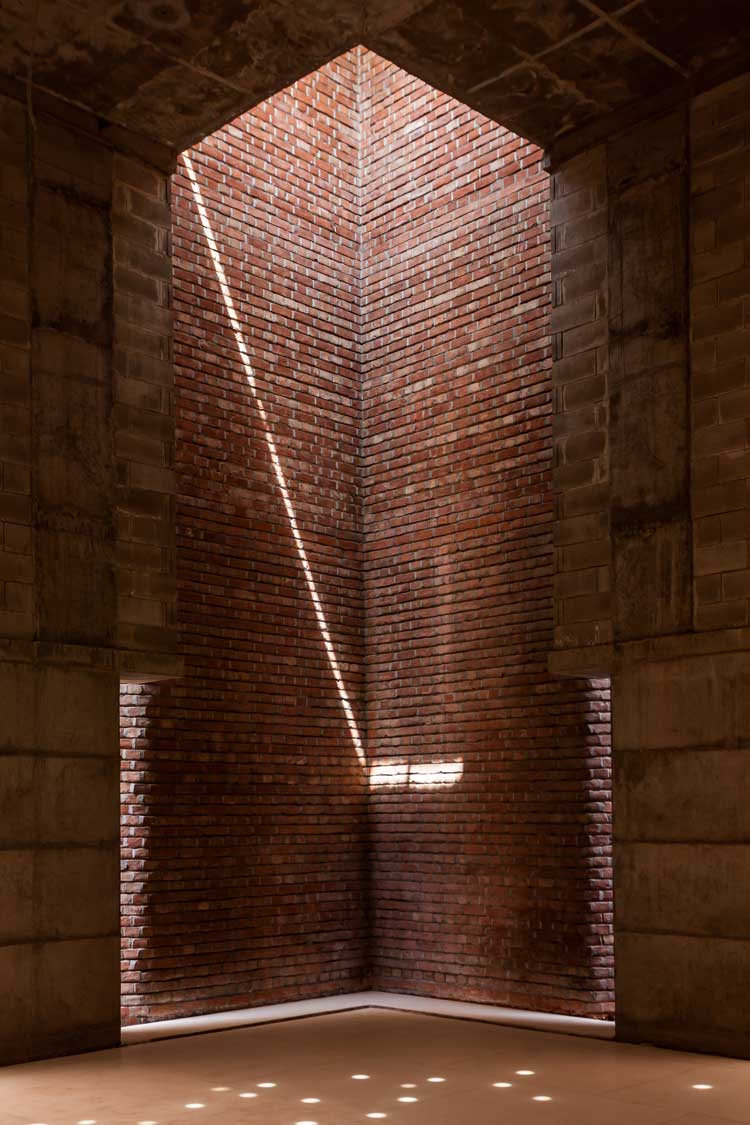
Bait Ur Rouf Mosque, Dhaka, by Marina Tabassum Architects. Photo: Hasan Saifuddin Chandan.
VS: Also, this project has an amazing story around it: that the community were so invested in the project, working so closely with you that they were helping to build it, and funding it as well, which is such a counter narrative to what was happening in global architecture at the time.
MT: That’s also important for me. A museum is a government project, and it was always a top-down process. You are designing a monument, but you are basically not connecting them with people, you are giving them what you think is the right answer to their brief. In a way, when you design a public space, if you do not include the public in the conversation, that creates a kind of disconnect. And that was a learning experience. When we were designing the mosque, a project of that nature has to have a sense of ownership from the people who are using it. If you do not include the people in the conversation, then you don’t create a sense of ownership. That can often turn it into a difficult situation where they don’t take care of their building.
VS: Your projects have won significant awards, so there must have been a point where you thought, OK, I am doing something right here, not just for my community, but for my professional community. How important has that been, personally and professionally?
MT: It’s important to be recognised. Very important. Because when you are walking a path that is less travelled, you are always in doubt. You are trying to create something where you don’t have a lot of precedents – especially coming from Bangladesh, where we don’t have a lot of precedents. We do have Muzharul Islam, who was a tremendously important architect for us, and brought in Louis Kahn to Bangladesh [Islam was initially invited to design the Capitol Complex and apparently handed the commission over to Kahn). I have a few earlier generation architects whom I look up to and who have similar values to those I try to embody in my work and in my practice. At the same time, I’m trying to carve a path in a different time. When you get acknowledged for the work that you’re doing, you do get a sense that you are doing something right, that you are being recognised, and people think this is a path that is important.
VS: Also, you are a female architect with a female-led practice and it has been so important for other women coming through architecture to see women making excellent buildings that are judged on a par with their peers. Wouldn’t it be great to reach a point where it doesn’t have to be stated how amazing it is for this female-led practice to be winning awards? But we are still in that space where it is the exception. In every part of the world.
MT: Yes, you just have to be twice as good (laughs). Especially in a profession like architecture. It’s not just a nine-to-five profession, it’s 24/7. It’s a constant process. It’s almost like a lifestyle. And when the world has seen women in a different light, to create a path and a lifestyle where you are on a par with your colleagues around the world, it’s not easy. It’s a struggle and involves a lot of sacrifices. And you have to be good.
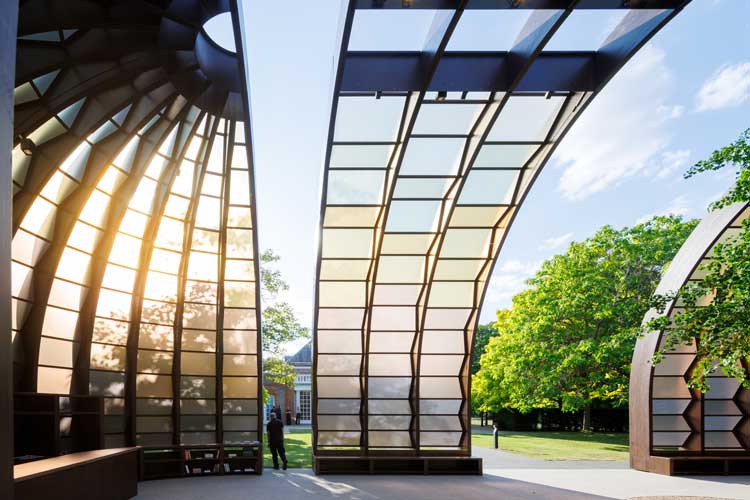
Serpentine Pavilion, 2025, A Capsule in Time, designed by Marina Tabassum, Marina Tabassum Architects (MTA). Exterior view. © Marina Tabassum Architects (MTA), Photo: Iwan Baan, Courtesy, Serpentine.
VS: And you have to love what you are doing so much that you are prepared to put up with all the pushbacks.
MT: It has to be a passion. Architecture is my life and my lifestyle, everything together.
VS: When did you start teaching and where?
MT: I started teaching in 2005, after 10 years of my practice, at Brac University of Bangladesh. I taught there for 10 years in the museum faculty. After that, off and on, I’ve been invited to teach in the US – at the University of Texas, at Harvard, at University of Toronto, Yale University. Now I hold a professorship at Delft University of Technology. I go there on a regular basis.
VS: Delft’s is a world-renowned architecture course. I can see why your principles would chime with Dutch architectural culture: it is very experimental and always in close contact with social and environmental sustainability.
MT: It’s a very rich architectural culture, and very enlightened in its planning. The connection between Bangladesh and the Netherlands is quite strong - both are deltas, very flat. I feel more at home there than anywhere else in Europe. And issues are quite similar in many ways. It’s about sea level rise for them, the climatic issues. They have a very small land mass, about a third the size of Bangladesh. But the way they have organised every single inch has been planned so beautifully. It’s phenomenal to see the amount of detailing that goes into planning an entire country. Everything is in its place. There is engineering and there is also nature, and that’s a beautiful combination.
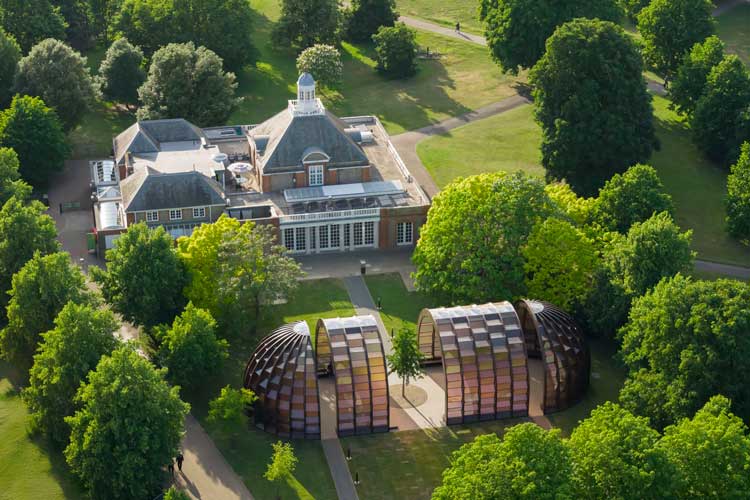
Serpentine Pavilion, 2025, A Capsule in Time, designed by Marina Tabassum, Marina Tabassum Architects (MTA). Exterior view. © Marina Tabassum Architects (MTA), Photo: Iwan Baan, Courtesy, Serpentine.
VS: It seems there the collaborations between built environment disciplines have been going on for ever – a good understanding between the engineering, landscape and architecture professions. Tell me about where you feel the architecture profession is at now, in terms of understanding the issues you felt were important 30 years ago?
MT: There seems to be polarisation, that’s how I feel. In one direction, there’s the capitalist mentality where you are constantly building and trying to cash in as much as possible - seeing buildings as a way of business. Which drives the disparity you see, not just in Bangladesh but anywhere in the world - building for a certain section of people who have more than enough while a certain section of people are struggling to make ends meet. In my country, it’s very pronounced. We need to bring those polarisations together at some point. This sustainability or working with community should not be a trend or a fashion. It needs to be much more valued, much more embedded. Our practice of architecture needs to be redefined in many ways, instead of being a service rendering profession, we need to create a renewed way of practice where you can bring everyone into the conversation. I think that’s so important.
VS: I feel young architects coming through have lots of purpose and optimism around those issues.
MT: That’s one of the reasons I teach, because this younger generation really gives me hope. My students come to me and say: “I don’t want to use any concrete.” I say: “Wonderful! So, what do you want to use?” These values they are trying to uphold are so important. Hopefully, we’ll see a new generation who will change the way we see architecture, construction and the building industry. We have built more than enough. Now we need to appropriate it according to people’s needs.
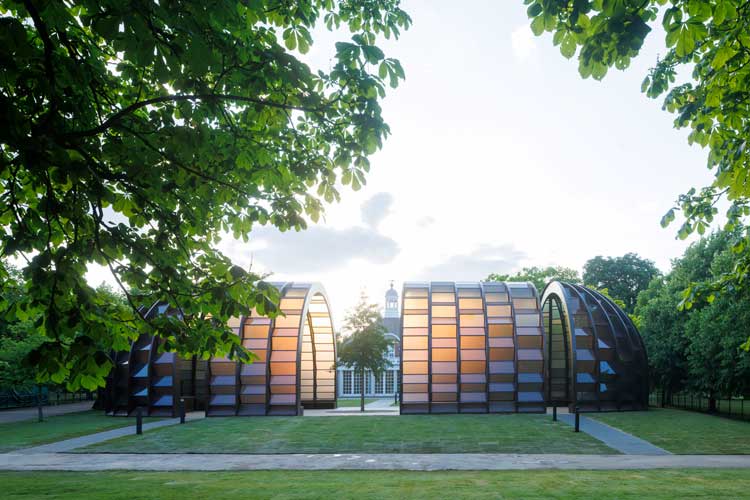
Serpentine Pavilion, 2025, A Capsule in Time, designed by Marina Tabassum, Marina Tabassum Architects (MTA). Exterior view. © Marina Tabassum Architects (MTA), Photo: Iwan Baan, Courtesy, Serpentine.
VS: That brings us neatly to what you felt you could bring to London, to Hyde Park, the Serpentine. You are joining such an illustrious list of names. What were your initial thoughts and how did they evolve?
MT: The Serpentine commission is quite celebrated in the architecture world. We all look to see who’s going to do the next one. When we received the commission, we were very excited by it. But at the same time, I’ve never built in London. I don’t know the construction industry as much. The building is here in the first five months but then it will probably travel. All these things came to mind. It’s about the celebration of summer months and at the same time what will happen as an afterlife. The afterlife was also very important. The idea was to design it backwards. You have a building which would then be used as a public space. Our intention is that, hopefully, it can become a library in its second life. You can see it’s a very archaic form, and at the same time addressing light, which for me is a very important material, it gives the atmosphere of the place. It’s also a celebration of gathering and people coming together. It was always about how we bring in light, make it a cheerful space but also a contemplative space, which has a connection to the park. You’re there in the space, but it’s porous enough to bring the park into the space. It was always about designing a structure that people would come to and spend enough time to enjoy it.
VS: What decisions did you take around materials? Were they also locally sourced?
MT: It has to be a dry construction, because it will move. We started from the foundations, which are reused from earlier pavilions. The structure is basically a wooden construction, locally sourced Glulam sections which are curved. And our initial idea was to have jute as a material to cover it, to bring in translucent light, but jute is not so great for fire rating. In the end, we went for polycarbonate, with a translucent film, which helps to bring in the light, and since this building will be used again. It’s all locally sourced, construction and everything. My first experience of building in London was a really enjoyable experience. But we’ll see where it goes.
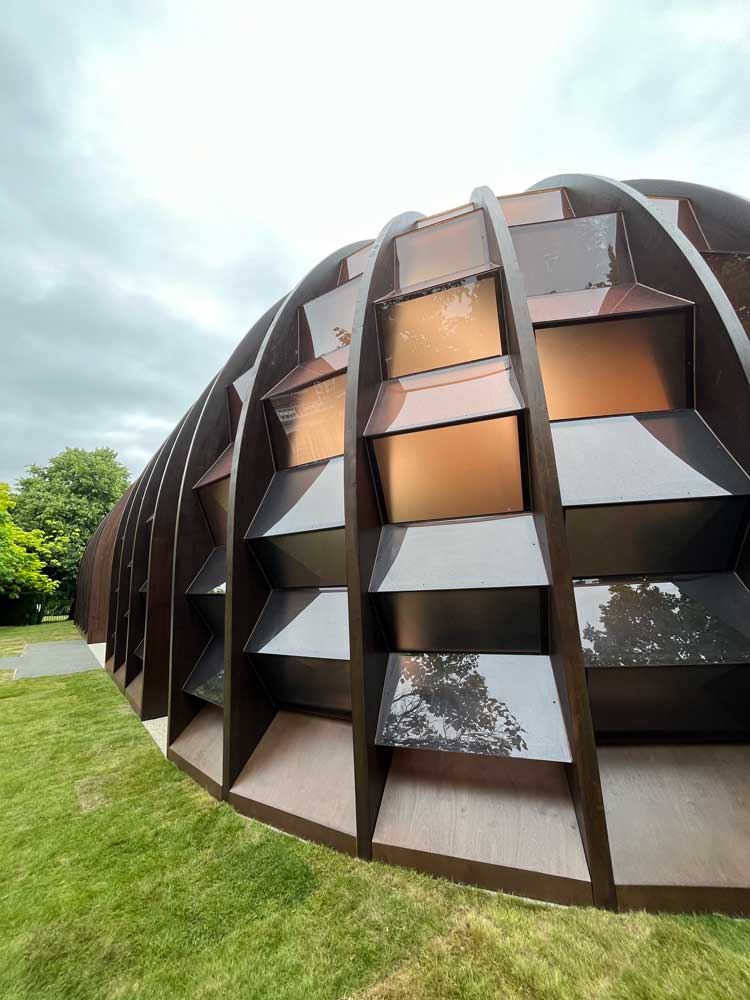
Marina Tabassum, A Capsule in Time, Serpentine Pavilion, London, 2025. Photo: Veronica Simpson.
VS: Do you have any exciting new projects on the cards?
MT: Bangladesh has gone through a political crisis, and we’re still in that situation where we’re struggling, there’s no proper government in place, an interim government. Work has been slow. We do have projects … The modular houses we’ve designed, that’s continuing, through the foundation we have created. But we don’t just do the houses. There’s a “working with livelihood” programme: to encourage good architecture, you need a proper economy in place specially for the people we build it for – if you can’t provide an economy there’s no point in building houses – so we are also working with livelihood, with craft, all those things are happening. We do all kinds of interesting projects.
VS: You must have many different experts within your office.
MT: It’s not like everyone sits in the office. We know a lot of like-minded people, and we try to bring them together, it’s like a collective. We are basically a collective where we are pulling in each other’s expertise and interests and dedication, and trying to create a team and work towards something we all believe in. They are people who have knowledge in landscape, crops, in creating craft. At the same time, we need hands-on architecture. There’s a lot of layering to that. It’s beautiful when you bring everything on board and become a much larger collective. Our achievements are not those of a single person – I represent a whole bunch of people.
VS: I would say that is a very inspiring definition of success: you have gathered around you similarly inspired and motivated people to benefit the wider ecology through all your skills.
MT: Yeah, I think so. If you took me back 30 years, I would do the same again.
• Marina Tabassum’s Serpentine Pavilion is open until 26 October.